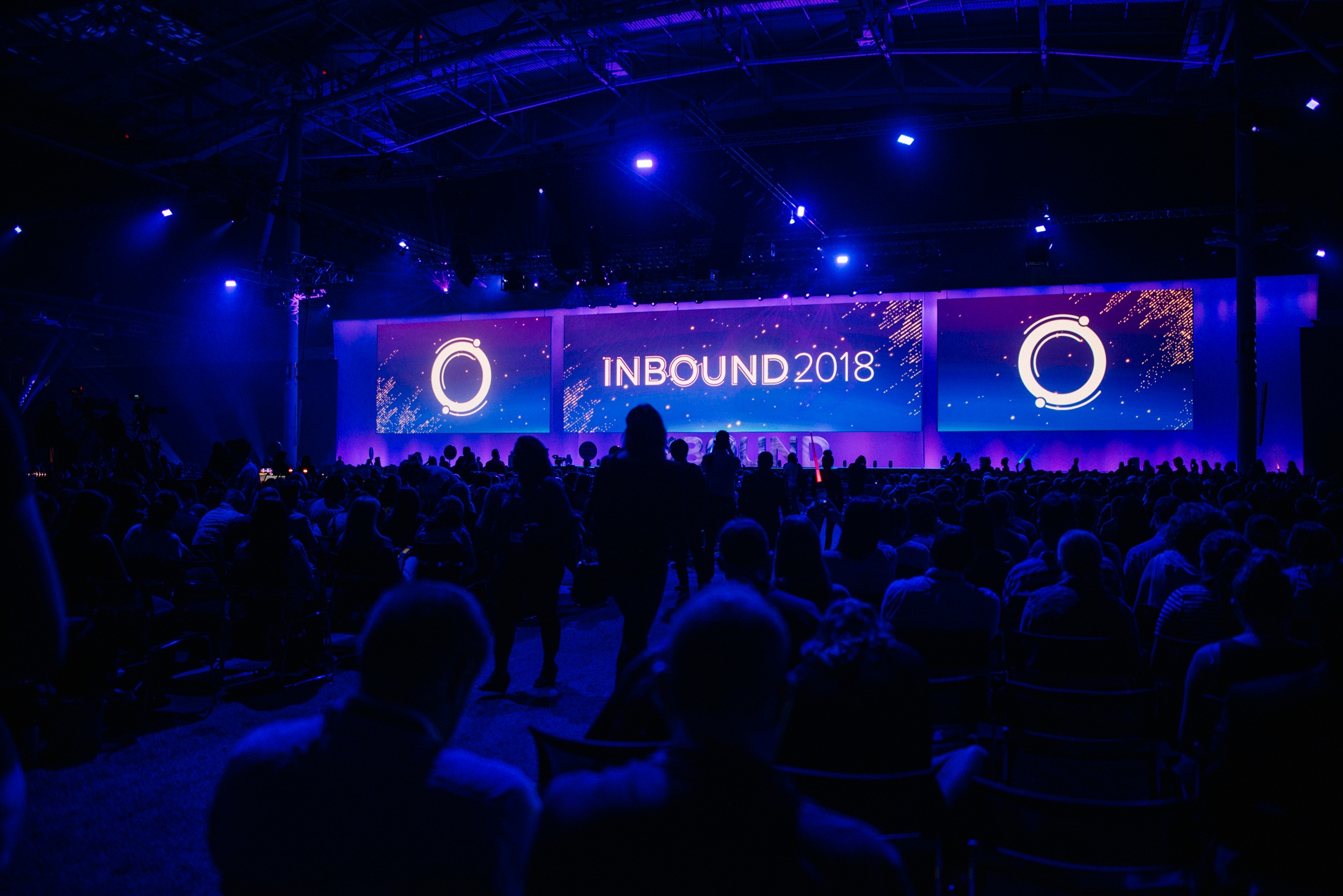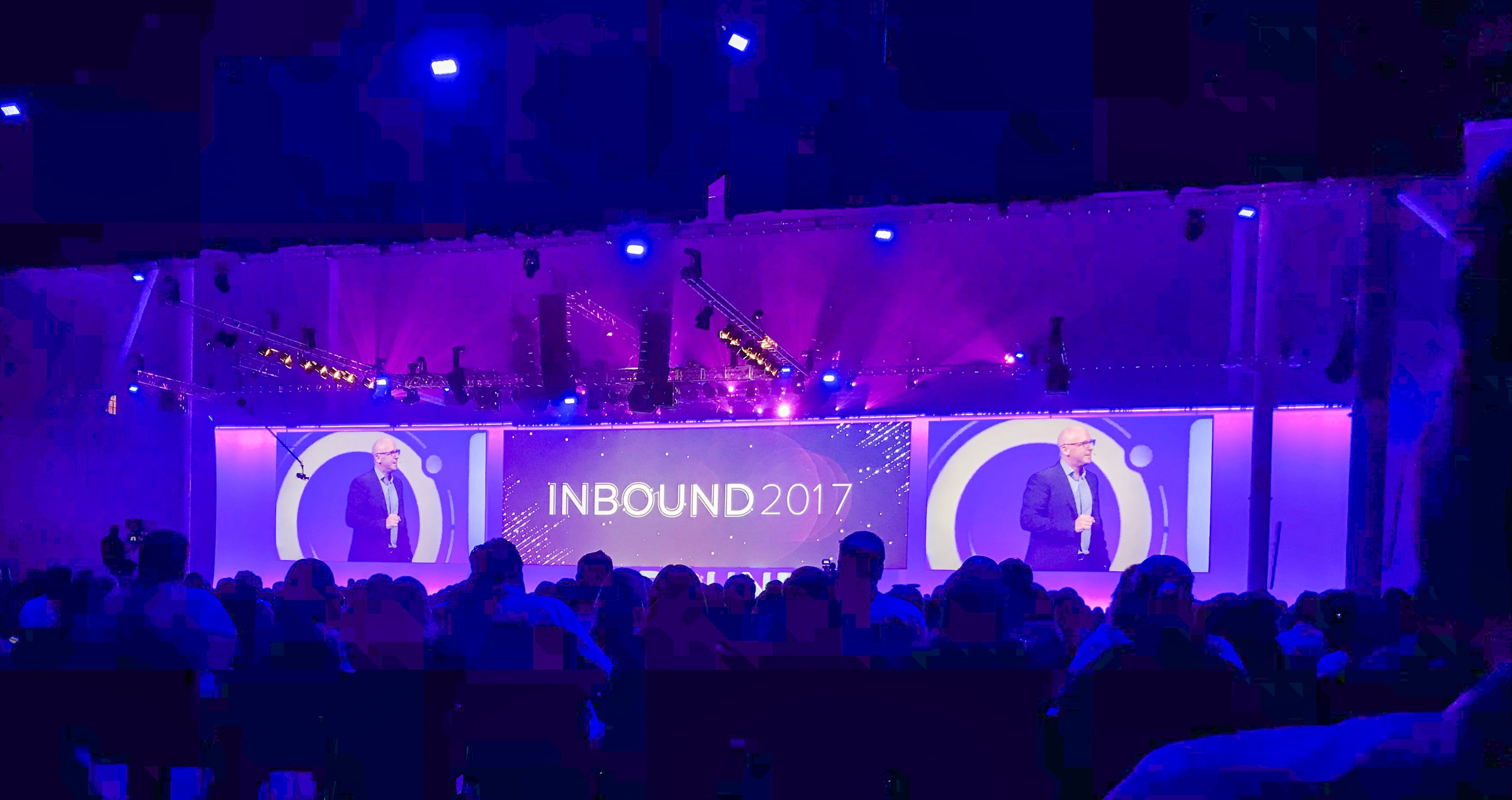Why Journalists Make the Best Blog Writers
In a piece about the difference between journalists and bloggers, Content Grip points out that the level of technique and skill of those with a...
16 min read
 Kevin Page
:
Sep 6, 2018 3:51:00 PM
Kevin Page
:
Sep 6, 2018 3:51:00 PM

Sadly, #INBOUND18 has come and gone! Five members of the StoryTeller team spent the week sharing insights, links, and takeaways from their favorite speakers and breakout sessions. Check out the recaps from all the amazing sessions presented by inspirational speakers like Scott Harrison, Shonda Rhimes, and Tarana Burke along with marketing superstars like Larry Kim, Rand Fishkin and HubSpot founders Brian Halligan and Dharmesh Shah.
Session by: Pamela Vaughan, Principal Marketing Manager, Website CRO & Copywriting, HubSpot
Recap by: Kevin Page, Account Strategist, StoryTeller Media + Communications
At times, Conversion Rate Optimization can seem like an impossible feat. There are so many variables that can determine your site-wide conversion rate, and it can be tough to know what’s working and what’s not working. During Pamela’s session, she showed us something she calls the CRO Umbrella. The umbrella consists of the items below:
As mentioned, this can be overwhelming. This is especially true if all of these responsibilities fall on the shoulders of one human being, which, unfortunately, is often times the case. So, how can you overcome this?
Pamela shared that there’s sadly no black and white solution. There’s no foolproof CRO best practice. Marketers are forced to find their own optimization opportunities, but there are some good “eye tests” to get you started in the right direction.
Speed: How fast does your site load?
Focus: Are there elements distracting users away from the desired goal?
Clarity: Is it clear to users what you’re selling?
Motivation: Are you appealing to the motivations of the users who arrived on your website?
Trust/Proof: How much do people trust your website/company and what you’re offering?
Usability: How easy is it for people to use your website and find/get what they’re looking for?
If nothing else, these questions can help you check the boxes and get you on the right track!
Session by: Rand Fishkin, Founder, SparkToro & Courtney Dagher, Content Project Manager, HubSpot
Recap by: Britt Laeger, Marketing Manger, StoryTeller Media + Communications
I’m a big Rand Fishkin fan. There are very few people in the digital marketing world who have the ability to comprehend and communicate the intricacies in a way that can resonate with people so naturally — maybe it’s the product of creating all those Whiteboard Friday videos.
During this AMA session, Rand gave several really interesting answers that held some helpful insights into the future of marketing and search (which I’ll get to in a minute), but what I found really interesting was the questions that were important for attendees.
Session attendees asked questions like these:
So, one thing seemed very clear to me, the world is not ready to stop hearing about SEO from Rand Fishkin. And I think that goes to show that marketers are still really unsure about what the recent shifts in SEO trends mean to their everyday life.
To summarize, here are a few of Rand’s notable responses:
The evolution of ranking trends doesn’t mean that we can stop worrying about what keyword phrases we are using in our content. It just means that the standard formula for SEO is no longer an accurate predictor of rankings, largely because many people are already doing that well.
In the same way that mobile didn’t kill desktop searches, voice search will not kill desktop results. It will, however, create alternate channels for ranking and search results that SEOs will need to understand and utilize.
Culture is not something a company can ever be without. It’s either explicit or it’s implicit. The sooner any company can create a code of values that is explicit, the better off the company will be. But it’s important to remember that your culture isn’t stagnant. It will change over time, it will change as you grow. Culture is malleable and that’s not bad.
Fear is something that plagues everyone. It's unlikely that anyone, Beyonce included, doesn't deal with fear on a regular basis. Fear is a natural response, it's how we react to that fear that makes a difference.
“I have plenty of experience with fearing failure. Not sure I have any story of overcoming it... I think when you stop fearing failure you’re probably done producing.” @randfish
— Christen Palange (@palangec17) September 6, 2018
Probably my favorite insight from #INBOUND18
When it comes to social media, we are playing two games:
Game one: Engagement within the platform, creating amazing content that keeps people on Google, Facebook, etc.
Game two: Creating content that drives results for your business. Views and conversions
Ultimately, these two games can work together, but if we don’t acknowledge the difference, we will fail at both.
If you are interested in learning more about what’s next for the former Wizard of Moz, check out SparkToro.com.
Session by: Marcus Sheridan, Keynote Speaker, Author & Owner, Marcus Sheridan International / IMPACT
Recap by: Kevin Page, Account Strategist, StoryTeller Media + Communication
So, I just left Sheridan’s session, and I feel like running through a brick wall! So much adrenaline! The guy knows how to deliver a punch. And, per usual, the punch was loaded with inspiring and insightful advice for everyone in attendance.
“If we create it, we own it.” This is why salespeople need to be involved in content creation. @TheSalesLion #INBOUND18 pic.twitter.com/jv66sje8t2
— Dan Gingiss #INBOUND18 (@dgingiss) September 6, 2018
The theme... trust. “Trust is always the answer.” Trust is something that has always been at the forefront of business transactions since the beginning of time. And that will never change. Marcus urged the audience to instill trust in your brand by answering the questions your prospects and customers are asking. It’s that simple. Here are a few tips from his session:
Answer negative or hard questions honestly. Questions like “What issues can I expect if I buy your products or services?”
Share your secret sauce. Your audience wants to know how you do what you do. “They want to see the sub made in front of them.”
Embrace reviews and create your own. But be honest, always. “Stop allowing third party sites to dictate your financial peace.”
Make your messaging personalized. And not just by pulling someone’s first name into the subject. Take the time to make something for them. Strive to get one of your prospects to say, “You made this for me?”
Unleash the power of self-selection and self-configuration. In other words, remove friction. Let them create their own journey through your sales process. If they create it, they will own it.
Be upfront with your pricing. They want to know. Stop saying pricing will scare your prospects away. It won’t! Do you know what will? If they can’t find it!
Show what you do, don’t just say it. Prove who you are and what you do by showing your personality and processes to your audience.
Session by: Rob Nelson, CEO, Grow
Recap by: Julia Tiedt, Account Strategist, StoryTeller Media + Communications
As marketers, we all possess a creative gene — that wonderful ability to think outside the box and a passion for coming up with ideas to deal with our company's or our clients' challenges. Sometimes, the data and analytics muscle is a little bit harder to flex. After all, we weren't math majors! But analytics is so important in what we do — it is the peanut butter to our strategy's jelly — because it tells us which of our ideas are working and which are not.
In his lecture, Rob Nelson, CEO of Grow, spoke about the benefits of tracking the right KPIs for your business. He said that when you do, beautiful things start to happen: your company's growth starts to accelerate, accountability naturally increases, execution becomes really good, and most importantly, everyone is having more fun. Those are pretty incredible outcomes of tracking data.
But you can't just pick random data, or even too much data to track, you have to create a framework for tracking KPIs. Rob says the secret sauce for cultivating these awesome KPI benefits is to outline what your framework or funnel looks like and then pick the 2-3 most important KPIs to measure and start from there. Just be sure you don't look at the data too regularly or you won't be able to identify trends.
Also, the thing that possibly resonated with me the most: celebrate your wins. Reaching a goal is huge, it's important to take time and recognize when these achievements have been reached. One of Rob's clients plays Van Halen on the office speakers every time their sales team hits their numbers for a period.
So, call a meeting of the minds and start identifying your 2-3 important metrics today. Then, watch the magic happen!
Session by: Frank Maguire, Sharethrough
Recap by: Ruth Glaser, Director of Sales and Marketing, StoryTeller Media + Communications
Whether it’s on social media or news publication sites, video ads are a crucial tool in educating and entertaining consumers. Native ads earn (rather than force) attention. This session offered some ideas on reinventing your videos to earn attention.
The state of video watching today
Conclusion: Video needs to be designed for the feed, not the couch.
Headlines.sharethrough.com is a free native video ad headline optimizer for marketers to optimize. It shows headlines' strengths and lists suggestions for how to improve it to trigger attention.
A small adjustment to video can have a huge impact on performance.
Session by: Chris O'Donnell, VP Product, HubSpot
Recap by: Kevin Page, Account Strategist, StoryTeller Media + Communications
Keynote by: Brian Halligan, CEO, HubSpot and Dharmesh Shah, CTO, HubSpot
Recap by: Brittany Laeger, Marketing Manager, StoryTeller Media + Communications
I’ve heard the feature keynotes from Brian Halligan and Dharmesh Shah many times. HubSpot’s keynote sessions aren’t supposed to provide the best tactical advice for me to take back to my job, but they are a rally cry to the world of sales and marketing to keep pushing forward.
And I have to say, as a 9-year veteran of the HubSpot platform, it’s a really amazing thing to see the leaders of the company still reinventing and evolving the company’s model to match the way that customers are buying.
The afternoon keynote was kicked off by Brian Halligan, CEO of HubSpot, who walked through the next evolution of the marketing funnel — what they call the flywheel.
While this type of clever rebranding can seem gimmicky at an arm’s length, this model is not simply the old marketing funnel reimagined in a circle.
“The old funnel shows customers as an output, when we all know that customers are actually an input to our business in today’s day and age” @bhalligan #Inbound18 pic.twitter.com/HNmsQ3n8zr
— Isabel Sanchez (@sanchezisabelm) September 6, 2018
The traditional funnel assumes that all customers follow a linear path, but it also treats customers like they are the end goal. In the world of Yelp and social media influencers, we know that the good opinion (or bad opinion) of a customer is a powerful force.
Today’s buyers have come to expect an experience that includes as little friction from the company as possible. (Think brands like Purple, Warby Parker, Spotify, and Lyft.)
Ultimately, Brian showed how this new growth model can scale with businesses and includes the efforts of your whole team, not just sales and marketing.
Get friction out of sales. @bhalligan's new growth model. #Inbound18 @HubSpot pic.twitter.com/Z6OZFqpefm
— The Mr Abdul 👍🏽 (@CaliAbdul) September 5, 2018
Next to hit the Inbound Stage was Dharmesh Shah, HubSpot’s CTO. It’s a rare treat to hear Dharmesh share his insights on the future of HubSpot.
This year, he shared his humble, but hilarious, insights on what it took for him to research and create the HubSpot Culture Code. It’s a 126-slide deck that details HubSpot’s company culture, and it has received more than 4 million views over the last several years.
While solving for the customer has always been part of the HubSpot Culture Code, it still left something to be desired.
So, the company created the Customer Code, another amazing 128-slide deck that shares common themes among customers and details how they want to be treated.
The Customer Code includes 10 principles.
These principles are as crucial to the success of our companies as your cultural core values. If you are not following these few rules, you won’t have a chance of delighting your customers.
Session by: Mari Smith, Facebook Marketing Expert
Recap by: Julia Tiedt, Account Strategist, StoryTeller Media + Communication
For years, we have heard all about the importance of the play button and incorporating video into your marketing strategy. Don't worry, video is still important — that hasn't changed, but the ways you use video are evolving.
In her talk, Mari Smith emphasized the growing importance of both live video and video on demand (VOD) platforms like Facebook and Instagram. I can be the first to admit that there are a lot of tools in both of these platforms that we have really just skimmed the surface in terms of their capabilities. But, it's time to rethink how we are going about our video strategy. Hint: You should never share a YouTube video on your Facebook Page — there's no point, it won't get traction — it needs to live there natively (if it is your own, of course).
With all of the changes happening with the Facebook algorithms, Mari believes that live and recorded video are really your loophole into reaching your audience. Facebook wants to compete with the likes of Netflix and Hulu (they still have a long way to go), and one of the ways you could potentially be successful is by becoming an early adapter. Mari spoke a lot about Facebook Watch, which is coming out later this year. This video channel will live on Facebook and will favor episodic content and content that is longer than three minutes.
“Create. More. Video.” -@MariSmith
— Chris Bryant 🎥 #INBOUND18 speaker (@The_ChrisBryant) September 5, 2018
Mari’s speaking my language! #INBOUND18 pic.twitter.com/Xmz115iFSE
It is also predicted that by the end of this year, Instagram Stories will be more popular than your Instagram feed. Better news, you can kill two birds with one stone and utilize your Instagram stories in your Facebook stories. Yep, you should START using Facebook stories, too. While not highly utilized yet, it will be, and probably soon.
So, make it a goal to create more video, and then take that video and amplify it. AND, use it in ways you haven't in the past. Because if there is one thing that creates a successful marketing plan, it's by testing different things out and seeing what works.
Session by: Carmen Simon, Cognitive Neuroscientist, Memzy
Recap by: Ruth Glaser, Director of Sales and Marketing, StoryTeller Media + Communications
We hear it over and over again — because of technology, our attention spans have become much shorter. Guess what? Not true! Our brains have not changed substantially in years; we are still capable of prolonged periods of attention. That’s great news!
The bad news? Modern audiences have significantly increased their threshold for stimulation. So, to engage an audience, marketers must overcome audience boredom. Boredom has two causes: dispositional — essentially, internally driven personality traits — and situational, which is caused by someone or something making you bored.
So worth the wait to see @areyoumemorable finally! I love the artwork in your slides. Definitely kept me engaged. #INBOUND18 @INBOUND pic.twitter.com/9m2B9YSndA
— Melanie Medina (@melaniemedina) September 5, 2018
Marketers can’t do much about dispositional factors, but you can influence situational factors. Here are the three ways to prevent boredom and engage your audience:
The brain stops noticing stimulus very quickly. Think of the rattling air conditioning vent in your office, for example. This is called habituation and can happen within 2-3 seconds if something doesn’t change!
When you’re looking for ways to vary content, consider varying the stimulus to maintain attention:
One type of stimulus is not better than the other — there is no right or wrong stimulus. It’s moving between them that keeps people engaged.
Other ways to provide variety:
But be mindful, too much stimulation can also cause boredom and disengagement. You need to anchor changes to patterns that people can return to.
Whenever something is challenging, you have a heightened stage of engagement. Methods to challenge include:
The brain enjoys that which is simple. But, when things are a bit more complex, we tend to lean in a bit and pay attention. Sometimes, we dumb things down too much for our audience — less is not always more. Instead, strive to give audience the joy of “getting it!"
How do you add complexity to content? Compare what audiences find boring vs. what’s not boring:
|
Boring content is:
|
Content that’s not boring is:
|
Today’s marketers must overcome boredom to engage the audience. Use variety, challenge, and complexity to avoid audience boredom and tap into the brain’s hardwiring for engagement.
Session By: Eric Keiles, CMO at Square 2 Marketing
Recap by: Kevin Page, Account Strategist, StoryTeller Media + Communications
We’re not too far into INBOUND 18, but a clear theme is continuing to surface... HubSpot’s Flywheel. Or, as Eric Keiles puts it, the Cyclonic Buyer's Journey. The traditional sales funnel is a thing of the past and the speakers of INBOUND 18 seem to be fully onboard with the movement.
Your marketing funnel doesn’t work in a consumer-centric world. The globe keeps turning even after conversion. Thus, we’ve created the flywheel, a new way of thinking about how customers interact with your business at every stage. #funneltoflywheel https://t.co/G7swCtkQPM pic.twitter.com/KjMUJpsfUe
— HubSpot (@HubSpot) May 10, 2018
Previous to the flywheel concept, we, as marketers, were trained to move leads down the sales funnel through the stages of Awareness, Consideration, and Decision. However, as the funnel continues to evolve, so do the stages.
Through this session, he outlined eight stages in the Cyclonic Buyer's Journey and also provided us with KPIs to pay close attention to in order to track how well we’re doing.
Eric urged us to laser-focus on the metrics your business identifies for each stage and strive for modest growth in each KPI. If you know data, you know that small increases in the data sets shared above can yield massive increases in your bottom line revenue.
Session by: Keenan, CEO, A Sales Guy
Recap by: Britt Laeger, Marketing Manager, StoryTeller Media + Communications
Many people believe the adage "people buy from people they like," but Keenan isn’t here for that. “People will still buy from you if they don’t like you... as long as you provide real value,” he says.
During his session, Keenan begged sales and marketing leaders to quit trying to be nice, instead, bring incredible value.
Ultimately, what it comes down to is that people don’t buy things just for the fun of it, they buy things to fix a problem that is plaguing their lives. In fact, Keenan (who was struggling with his presentation remote) said he would pay someone money just to have a remote that worked.
Sales and marketing leaders often fail to identify the real problem, the ultimate impact, and the root cause. All of these pieces will make your sales case that much stronger.
Keenan believes that by showing the gap between the future state that your product or service offers and the current state that a company is living in, you can best illustrate how much value your company can really bring to the table.
Sales people are changers. Take advantage of that to take advantage of the value you provide. #INBOUND18 @keenan pic.twitter.com/c8zewaLko3
— Kim Doughty (@Howdy_Doughty) September 5, 2018
By gathering the information you need to make this case, you should be able to combat any objections that arise throughout the sales process.
Recap by Britt Laeger, Marketing Manager, StoryTeller Media + Communications
The official #Inbound18 festivities were kicked off by none other than Deepak Chopra, a best-selling author, and alternative medicine advocate. Deepak shared insights on how our bodies cope with stress, anxiety, and pain, and ultimately, how that impacts our ability to operate at our highest potential.
"80% of people who go to work disengaged or even “actively disengaged” have the purpose of making other people unhappy."
- Deepak Chopra
He also shared that there are three drivers that contribute to the success of any business or creative team:
Chopra went on to share the six pillars of emotional wellbeing, detailing how each one positively and negatively can affect the body, before leading the whole room in a short meditation session.
Pretty good @DeepakChopra, but you forgot #7: a decent marketing automation platform 😛#INBOUND18 #HubSpot pic.twitter.com/e0kVaU6jWJ
— Colleen Barry (@colleenkbarry) September 4, 2018
Session by: Dan Tyre, Hubspot & Jackie Steinmetz, Accelity Marketing
Recap by: Ruth Glaser, Director of Sales & Marketing, StoryTeller Media + Communications
This Partner Day presentation could have been renamed, “Get over yourself and pick up the phone already.” Sales calling does not come naturally for most people, but those who pick up the phone, win the deals!
Dan Tyre runs an 8-week boot camp for salespeople to learn new skills for opening more doors, connecting with more prospects, and generating more opportunities so they can close more deals and grow their businesses.
Jackie Steinmetz is a graduate (or “Lion” in boot camp parlance) of the boot camp. Together, they offered some great tips to generate opportunities:
These are people who were interested in what you have to offer but disappeared before you could close the deal. They offer some great conversation starters:
These open-ended questions allow you to learn more and re-engage this contact.
Dan and Jackie also offered tips to tackle the dreaded cold calls.
Before the call: Do your research. Spend 3-5 minutes on LinkedIn, Social Media, and the company website. Look for pictures to gain insight into how to connect with the prospect.
Make the call:
Dan recommends a free Chrome extension to assess the prospect’s DISC personality type. Learn if the prospect likes small talk or whether you need to cut right to the chase! Check it out: Crystal Knows

In a piece about the difference between journalists and bloggers, Content Grip points out that the level of technique and skill of those with a...

As StoryTeller's talented Accounts Director, Amanda Weldon is a driving force behind the seamless collaboration between the internal team and a...

Looking for more great marketing insights? Check out the Inbound 2018 Recap on our blog! Inbound 2017 took place in late September and the...